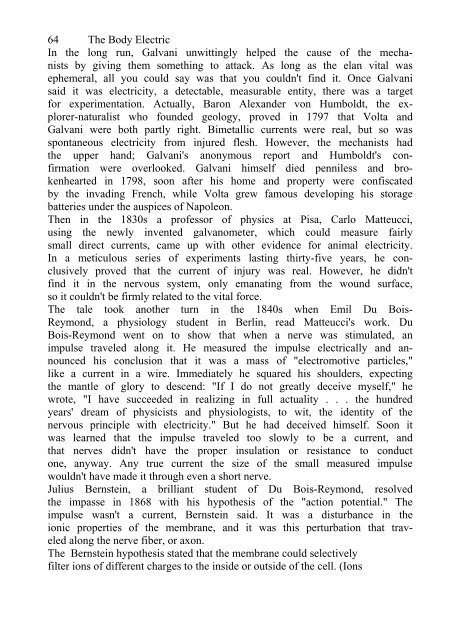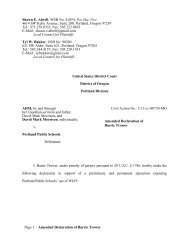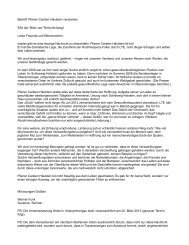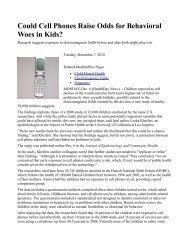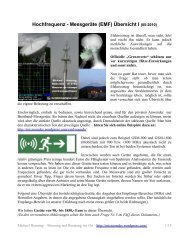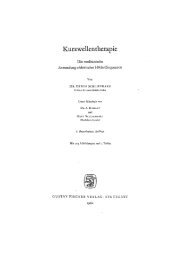The Body Electric - Micro-ondes
The Body Electric - Micro-ondes
The Body Electric - Micro-ondes
You also want an ePaper? Increase the reach of your titles
YUMPU automatically turns print PDFs into web optimized ePapers that Google loves.
64 <strong>The</strong> <strong>Body</strong> <strong>Electric</strong><br />
In the long run, Galvani unwittingly helped the cause of the mecha-<br />
nists by giving them something to attack. As long as the elan vital was<br />
ephemeral, all you could say was that you couldn't find it. Once Galvani<br />
said it was electricity, a detectable, measurable entity, there was a target<br />
for experimentation. Actually, Baron Alexander von Humboldt, the ex-<br />
plorer-naturalist who founded geology, proved in 1797 that Volta and<br />
Galvani were both partly right. Bimetallic currents were real, but so was<br />
spontaneous electricity from injured flesh. However, the mechanists had<br />
the upper hand; Galvani's anonymous report and Humboldt's con-<br />
firmation were overlooked. Galvani himself died penniless and bro-<br />
kenhearted in 1798, soon after his home and property were confiscated<br />
by the invading French, while Volta grew famous developing his storage<br />
batteries under the auspices of Napoleon.<br />
<strong>The</strong>n in the 1830s a professor of physics at Pisa, Carlo Matteucci,<br />
using the newly invented galvanometer, which could measure fairly<br />
small direct currents, came up with other evidence for animal electricity.<br />
In a meticulous series of experiments lasting thirty-five years, he con-<br />
clusively proved that the current of injury was real. However, he didn't<br />
find it in the nervous system, only emanating from the wound surface,<br />
so it couldn't be firmly related to the vital force.<br />
<strong>The</strong> tale took another turn in the 1840s when Emil Du Bois-<br />
Reymond, a physiology student in Berlin, read Matteucci's work. Du<br />
Bois-Reymond went on to show that when a nerve was stimulated, an<br />
impulse traveled along it. He measured the impulse electrically and an-<br />
nounced his conclusion that it was a mass of "electromotive particles,"<br />
like a current in a wire. Immediately he squared his shoulders, expecting<br />
the mantle of glory to descend: "If I do not greatly deceive myself," he<br />
wrote, "I have succeeded in realizing in full actuality . . . the hundred<br />
years' dream of physicists and physiologists, to wit, the identity of the<br />
nervous principle with electricity." But he had deceived himself. Soon it<br />
was learned that the impulse traveled too slowly to be a current, and<br />
that nerves didn't have the proper insulation or resistance to conduct<br />
one, anyway. Any true current the size of the small measured impulse<br />
wouldn't have made it through even a short nerve.<br />
Julius Bernstein, a brilliant student of Du Bois-Reymond, resolved<br />
the impasse in 1868 with his hypothesis of the "action potential." <strong>The</strong><br />
impulse wasn't a current, Bernstein said. It was a disturbance in the<br />
ionic properties of the membrane, and it was this perturbation that trav-<br />
eled along the nerve fiber, or axon.<br />
<strong>The</strong> Bernstein hypothesis stated that the membrane could selectively<br />
filter ions of different charges to the inside or outside of the cell. (Ions


